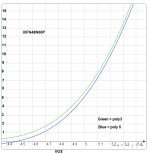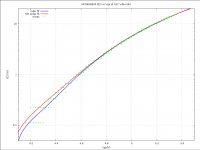Yes, I ran a couple simulations earlier and noticed improved phase and gain margins. Will have to adjust local feedback levels, or I won't have enough overall gain.
I just seemed to recall something about needing low resistor values for current feedback amps, but don't remember why... Maybe it was from working with high-bandwidth opamps...
The funny is that in the opto variant PR showed in my Spice with 500R gain resistor and 5k i get oscillations , the beast begins to show overshot in the rectangle.
Only with a 39k at the JFet input you can dampened it.
I suppose Lynn's statement with the higher bandwidth explains the matter.
I have been making more tweaks and measurements of the one channel I have built. I am beginning to believe that careful matching of the J74/K170 JFETs, J313/K2013 MOSFETs, and IXYS hocky-pucks is required to obtain the distortion plots that are shown in the XA25 User Manual. Measurements of H3 and higher look pretty good, but I haven't yet been able to enough H2 to get very close the the levels shown in those plots. How many of us have a stockpile of NOS JFETs and MOSFETs and can afford to purchase sufficient quantities of the hocky-pucks to do matching? Nelson continues to find ways to screw the cloners.
I am sure that Nelson all this does....!
We can only compensate this by declaring our beasts not to be a clone but an
Iclone.......😀😀😀
I am sure that Nelson all this does....!
We can only compensate this by declaring our beasts not to be a clone but an
Iclone.......😀😀😀
Put a big enough fans on it and it becomes a cyclone.
Yeah got all that.How many of us have a stockpile of NOS JFETs and MOSFETs and can afford to purchase sufficient quantities of the hocky-pucks to do matching?.
HA, Ha very good Lynn!
It's like one of those rare moments on Startrek where Spock cracks a joke.
Hahaha
Pico: Back in posts #353 and #355 http://www.diyaudio.com/forums/pass-labs/300233-f4-beast-builders-36.html#post4944615 you indicated that you had a SPICE model for the IXFN48N60P. Can you make that model available? My build is with the IXFN48N60P part, but my LTSpice sims are with the IXFN44N80Q3 model, which has a much lower transcondictance.
Yeah.
It is based on very simple model parameters.
It is very accurate over the 0 to 3A range with my test results but then deviates away from your results above that region.
I can only measure to 3A on my lab power supply.
Can you double and triple check your transconductance curve fit above 4A.
Also could you redo your Id vs Vgs results again just to be certain.
It is based on very simple model parameters.
It is very accurate over the 0 to 3A range with my test results but then deviates away from your results above that region.
I can only measure to 3A on my lab power supply.
Can you double and triple check your transconductance curve fit above 4A.
Also could you redo your Id vs Vgs results again just to be certain.
Once you've double checked it, I will either post it unchanged or make the necessary corrections.
Once you've double checked it, I will either post it unchanged or make the necessary corrections.
Attached is raw Id vs. Vgs ramp data and jpeg files from of Rigol DS1054Z screen. I also have performed least-squares polynomial fits to that data, shown below. The columns in the raw data files are : Vgs, Id. The accuracy of the raw data is on the order of 1%, but the polynomial fits are much better.
IXFN48N60P
poly3: Id=8.92663*Vgs^3-111.878*Vgs^2+468.086*Vgs-653.668
poly5: Id=-3.31238*Vgs^5+76.9572*Vgs^4-704.511*Vgs^3+3187.0*Vgs^2-7140.02*Vgs+6347.62
IXTN40P50P
poly3: Id=5.42572*Vgs^3-41.4152*Vgs^2+105.155*Vgs-88.7311
poly5: Id=-4.81365*Vgs^5+73.1984*Vgs^4-437.739*Vgs^3+1293.81*Vgs^2-1896.84*Vgs+1106.28
Attachments
Attached is raw Id vs. Vgs ramp data and jpeg files from of Rigol DS1054Z screen. I also have performed least-squares polynomial fits to that data, shown below. The columns in the raw data files are : Vgs, Id. The accuracy of the raw data is on the order of 1%, but the polynomial fits are much better.
IXFN48N60P
poly3: Id=8.92663*Vgs^3-111.878*Vgs^2+468.086*Vgs-653.668
poly5: Id=-3.31238*Vgs^5+76.9572*Vgs^4-704.511*Vgs^3+3187.0*Vgs^2-7140.02*Vgs+6347.62
IXTN40P50P
poly3: Id=5.42572*Vgs^3-41.4152*Vgs^2+105.155*Vgs-88.7311
poly5: Id=-4.81365*Vgs^5+73.1984*Vgs^4-437.739*Vgs^3+1293.81*Vgs^2-1896.84*Vgs+1106.28
Hard to find good square law perfection these days. 😉
Hard to find good square law perfection these days. 😉
Yup. One interesting observation looking at the plots of gm vs. Id, is that the slopes and curvatures are different, which means indicates the presence of unequal harmonics above first order. I need to convert those polynomials into harmonic series expansions at the idle current. Then they will represent something directly related to the harmonic distortion of the FETs.
Yeah it's quite a bit different than expected hence the reason for asking to check it.
I might use a different supply and see whether my results are the same as yours at the higher levels of Id.
I'm not expecting perfect matching but at least the same sought of trend.
I might use a different supply and see whether my results are the same as yours at the higher levels of Id.
I'm not expecting perfect matching but at least the same sought of trend.
Yeah it's quite a bit different than expected hence the reason for asking to check it.
I might use a different supply and see whether my results are the same as yours at the higher levels of Id.
I'm not expecting perfect matching but at least the same sought of trend.
Some more info: The measurements are at approximately 50C heatsink temperature. I used a 1% 0R18 current sense resistor for the Id measurements. These sweep measurements were spot checked against measurements made in very a different manner and they agreed within 1%-2%.
I am glad to brought up this subject. It made me realize that I should be able to predict the push-pull harmonic spectrum of the output stage driven by a perfect front-end for a low frequency input. It is a relatively simple procedure.
You are partially correct. I truncated the number of digits in the polynomial coefficients, and it shows for Id < 1A. Here it what my plots show. Note the vertical axis is log-scale.
Here are the polynomials with 2 more digits per coefficients.
IXFN48N60P
poly3b:8.9266293*Vgs^3-111.87771*Vgs^2+468.08582*Vgs-653.66802
poly5b:-3.3123769*Vgs^5+76.957238*Vgs^4-704.51148*Vgs^3+3186.9992*Vgs^2-7140.0232*Vgs+6347.6198
I am working of a better set of polynomials expanded around either the and estimate of Vth (threshold) or Vgs at the idle current.
Plot on the left: 6 digits per coefficient.
Plot of the right: 8 digits per coefficient.
Here are the polynomials with 2 more digits per coefficients.
IXFN48N60P
poly3b:8.9266293*Vgs^3-111.87771*Vgs^2+468.08582*Vgs-653.66802
poly5b:-3.3123769*Vgs^5+76.957238*Vgs^4-704.51148*Vgs^3+3186.9992*Vgs^2-7140.0232*Vgs+6347.6198
I am working of a better set of polynomials expanded around either the and estimate of Vth (threshold) or Vgs at the idle current.
Plot on the left: 6 digits per coefficient.
Plot of the right: 8 digits per coefficient.
Attachments
Last edited:
- Home
- Amplifiers
- Pass Labs
- F4 Beast Builders



